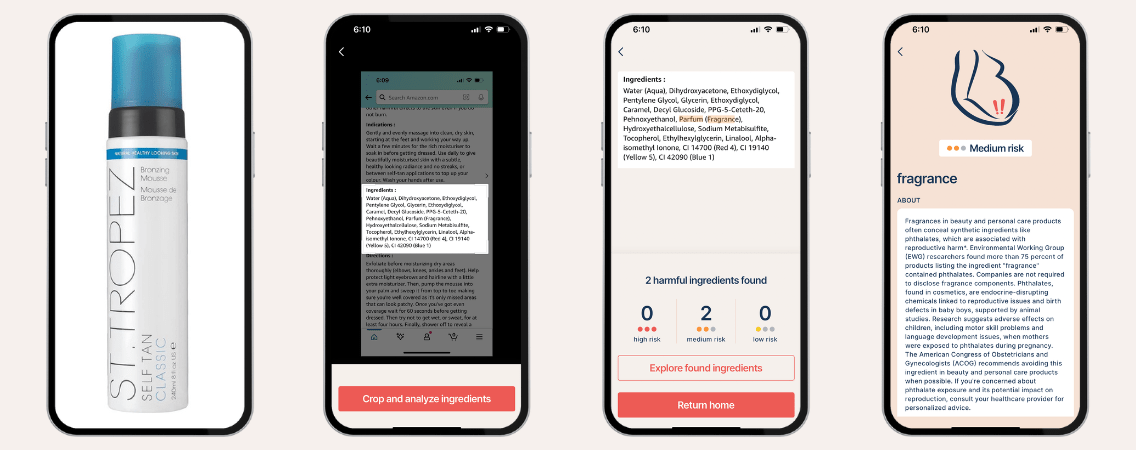Pregnancy is a time of immense joy and anticipation, yet it also encourages a heightened emphasis on safety in all aspects of life, including beauty routines. Expectant mothers often wonder about the safety of self-tan products during this delicate period. Let’s explore the importance of finding a pregnancy-safe self-tanner.As expectant mothers, your priority is the well-being of both yourself and your developing baby. Traditional sun exposure or tanning beds are not recommended during pregnancy due to the risk of skin damage and increased sensitivity to UV radiation. This underscores the importance of finding alternative methods to achieve a healthy glow, making sunless tan products an appealing option.
Can You Use Self Tanner While Pregnant?
Many expectant mothers express valid concerns about the safety of self-tan products during pregnancy. While achieving a sun-kissed glow can undoubtedly boost confidence and appearance, lingering questions persist regarding the potential risks associated with these products in pregnancy. Therefore, it’s essential to thoroughly weigh these concerns against the benefits of maintaining a beauty routine that prioritizes the well-being of both you and your developing baby.
A primary ingredient in most self-tan products is DHA (Dihydroxyacetone), which interacts with the skin to create a temporary tan. Although DHA is regarded as safe for external use, concerns arise regarding its potential absorption into the bloodstream, particularly through inhalation.
According to the National Library of Medicine (NLM) there are currently no studies available if self-tanners increase the chance of miscarriage or if it affects fertility.
Best Self Tanner for Pregnancy – Little Bean Approved!
Here’s a list of other Little Bean-approved best self-tanning products that are pregnancy-safe and are loved by our users:
-
- Skinnerals by Californium Self Tan Mousse: This self-tanner is vegan, cruelty-free, and hydrating, formulated to nourish skin and smooth out blemishes and stretch marks. It’s oil-free and contains organic ingredients like DHA, Aloe, Gooseberry, and Acai. Customers appreciate its minimal scent and instant results, suggesting moisturizing before application and using Vaseline on rough areas like toes and the back of knees for better coverage.
- Beauty by Earth Self Tan Lotion: Achieve a natural, sun-kissed glow with this self-tanner available in two shades: fair to medium and medium to dark. Customers appreciate its ease of application, pleasant scent, and the fact that the fake tan doesn’t transfer to clothing or bedsheets.
- B.tan sunless tanner mouse: This self-tanner is vegan, cruelty-free, and free from harmful additives. Its 1-hour express formula is suitable for both face and body application. Customers appreciate its effective tanning results, subtle scent, and the added benefit of a colored product for easier application tracking.
Common Ingredients in Self-Tanners and Their Safety
DHA, a key component in many self-tan products, stands apart from the omega-3 fatty acid found in food. Applied topically, it interacts with the skin’s outer layer, providing a temporary sun-kissed glow that lasts about a week. While generally considered safe for external use, questions about its safety during pregnancy linger. Moreover, self-tanners typically contain additional ingredients like moisturizers, fragrances, and preservatives, each deserving careful consideration for expectant mothers, as we’ll explore further.
Research conducted by the National Library of Medicine (NLM) has provided valuable insights into the safety of skincare products, including self-tanning agents, for pregnant women. These products commonly feature DHA, typically ranging from 1% to 15% concentrations. The study revealed minimal systemic absorption, approximately 0.5%, when applied topically. For context, most over-the-counter self-tanning products boast DHA concentrations between 3% and 5%, while professional-grade variants may escalate to 5% to 15%. Notably, DHA is sourced from natural origins like sugar cane and sugar beets.
Research indicates that DHA may not penetrate beyond the outermost layer of the skin. While studies on this topic are limited, it is estimated that at most 0.5% of DHA is absorbed into the bloodstream when self-tanners are applied to the skin. While this suggests a reduced risk of absorption into the bloodstream, it also highlights the need for further research to advise caution for women using self-tan products during pregnancy.
Self Tan While Pregnant: Precautions and Recommendations
Dihydroxyacetone (DHA) is a prevalent chemical in self-tanning products, known for delivering a sun-kissed glow to the skin. However, when opting for spray tans, there’s a potential risk of DHA exposure through the eyes, nose, or mouth. Consequently, the FDA has sanctioned DHA for topical application, endorsing its use in mousses or lotions while cautioning against its aerosol application.
Pregnant women considering self-tan products should take certain precautions to minimize potential risks. These precautions include:
- Conducting a patch test before the full application
- Applying self-tanner in a well-ventilated area to reduce inhalation risks
- Wearing gloves to avoid direct contact with the product
- Refraining from applying self-tanner to areas with mucous membranes
Here are some tips to achieve successful self-tanning:
- Start by exfoliating your skin thoroughly and removing any unwanted hair 12-24 hours before applying the fake tan. During pregnancy, it’s safe to use an AHA lotion or scrub for exfoliation.
- Prior to application, moisturize dry areas such as knees, elbows, and wrists to prevent excessive absorption of color.
- Utilize a self-tanning mitt to shield your palms and ensure an even application. Apply the tanner to clean, dry skin in smooth, circular motions, starting from the legs and working your way up. Use less product on elbows, wrists, hands, knees and feet. See below for some pregnancy-safe product recommendations.
- Use a kabuki brush to apply self-tan to challenging areas like the face, ears, feet, and hands.
- Allow the tan to develop according to the product’s instructions for the specified time. For instance, wait 2+ hours before rinsing off with warm water (without using soap).
- Moisturize daily to maintain your glow!
Are any self-tanners safe during pregnancy?
For expectant mothers, prioritizing safety during pregnancy involves selecting self-tanners free from potentially harmful ingredients like phthalates, hydroquinone, and parabens. Opt for products containing natural and organic ingredients to ensure pregnancy safety. Little Bean offers a user-friendly pregnancy-safe ingredient checker, accessible on both IOS and Android platforms, facilitating easy identification of any potentially harmful components in your self-tanner.
It’s important to note that self-tanners typically do not offer sun protection and should not be relied upon as a substitute for sunscreen. When exposed to the sun, ensure to apply a broad-spectrum sunscreen with SPF 30 or higher to shield your skin from harmful UV rays and prevent sun damage.
Choosing the Right Product: Pregnancy Safe Self Tanners
Self-tan products are available in various formulations, including lotions, sprays, foams, and mousses, each offering unique benefits and application techniques.
- Self tan foam: Known for its fast-drying properties, self tan foam formulations are popular choices for those seeking quick results. It’s important to note that these often contain other ingredients like synthetic fragrance (which may contain phthalates), parabens or formaldehyde-releasing preservatives (such as DMDM hydantoin and imidazolidinyl urea)
- Self tan lotions: These formulations can also provide moisturizing benefits, which is particularly helpful during pregnancy when skin tends to be drier and more prone to stretch marks.
- Self tan mousse: With its lighter, airier texture compared to foam, self tan mousse formulations offer easy application. They often feel whipped and spread evenly across the skin with ease. Mousse is commonly dispensed from a pump bottle, allowing for quick absorption into the skin.
- Self spray tan: Spray formulations provide a convenient and efficient way to apply self-tanner, offering even coverage and a seamless finish. They are often preferred for hard-to-reach areas and can be quickly applied with minimal mess. However, as mentioned above using them in a well-ventilated area is essential to avoid inhaling the product.
Pregnant women should choose the best self tan products that are free from potentially harmful ingredients and offer easy application to minimize the risk of adverse reactions. While there’s a wide array of fake tan products available in the market, not all are suitable for use during pregnancy.
Common questions arise, such as:
Can I use St Tropez while pregnant?
We checked their best-selling product, the classic bronzer mouse, with our pregnancy-safe ingredient checker.

It’s immediately clear from examining the ingredient list that this product includes ‘fragrance. Fragrances commonly contain phthalates, which, despite potential health risks, are not mandated by the FDA to be listed separately on product labels. Instead, they are often categorized as part of fragrance blends or proprietary formulas, exempting them from federal labeling regulations. Research has linked prenatal exposure to phthalates with potential motor skill difficulties in children. Therefore, this product fails to meet the rigorous 100% Little Bean-approved criteria for a pregnancy-safe self-tanner.
Is Coco and Eve self-tanner safe during pregnancy?
When reviewing the Coco and Eve self-tanner mousse, our scanner once more identified the presence of the ingredient “fragrance.”It’s worth noting that the Environmental Working Group (EWG) estimates that approximately 75% of products listing “fragrance” on their ingredient labels contain phthalates. However, upon checking Coco and Eve’s website, they assert that their products are formulated without sulfates, parabens, and phthalates, claiming to be “zero nasties.” As a result, their pregnancy-safe self-tanner products are deemed 100% Little Bean-approved. The presence of fragrance is a unique case, as detailed in our ingredients’ description. To ensure the absence of phthalates in the product, checking the brand’s website or contacting them directly is the only viable option.
Can You Self Tan in Pregnancy: Expert Opinions
Skincare experts and obstetricians offer valuable insights into the safety of fake tan products during pregnancy. While opinions may vary, many professionals emphasize the importance of moderation and adherence to safety precautions when using these products during pregnancy.
How bad is it to tan while pregnant?
Tanning beds and sunbathing are generally discouraged during pregnancy due to potential risks. Prolonged exposure may elevate body temperature, posing a risk of overheating and dehydration. Additionally, research indicates a connection between UV radiation exposure and the breakdown of folic acid, a crucial nutrient for preventing neural tube defects in fetuses. Opting for a sunless tan is often considered a safer alternative during pregnancy.
Regarding concerns about self-tanning products exacerbating conditions like melasma, commonly referred to as the “mask of pregnancy,” it’s important to note that while these products can darken the skin temporarily, they typically do not directly worsen melasma. However, given that sunlight can exacerbate melasma, protecting the skin from UV exposure with SPF 30+ is crucial, emphasizing the importance of sunless tanning as a safer option during pregnancy.
Additionally, myths surrounding DHA absorption and potential harm to the baby persist regarding self-tanning during pregnancy. Nevertheless, when applied correctly and with the use of pregnancy-safe self-tanners, the associated risks are generally minimal. Furthermore, incorporating vitamin C into skincare routines might aid in managing conditions like melasma, given its antioxidant properties that can brighten the skin and reduce the appearance of dark spots. For more information, you can read our previous blog on the best vitamin C serum safe for pregnancy. As always, consulting a healthcare provider before starting any new skincare regimen during pregnancy is advisable.
Final Thoughts: Balancing Safety and Beauty in Pregnancy
In conclusion, navigating the realm of pregnancy-safe self-tanning requires careful consideration and awareness of potential risks. While traditional methods like sun exposure and tanning beds are discouraged, opting for fake tan products can offer a safer route to achieving that radiant glow.
By understanding the ingredients, such as DHA, and following recommended precautions, expectant mothers can confidently choose the best self tan options for their needs, ensuring both beauty and safety during this special time.
Remember, prioritizing safety and consulting with healthcare professionals is key when incorporating fake tan into your pregnancy skincare routine. With the right knowledge and approach, self-tanning can be a delightful addition to your beauty regimen, promoting a healthy and radiant complexion throughout pregnancy.
Up next: pregnancy safe eye cream
Self-tanners, Tanning Pills, Tanning Booths | National Center for Biotechnology Information
Safety of skin care products during pregnancy | The College of Family Physicians of Canada

